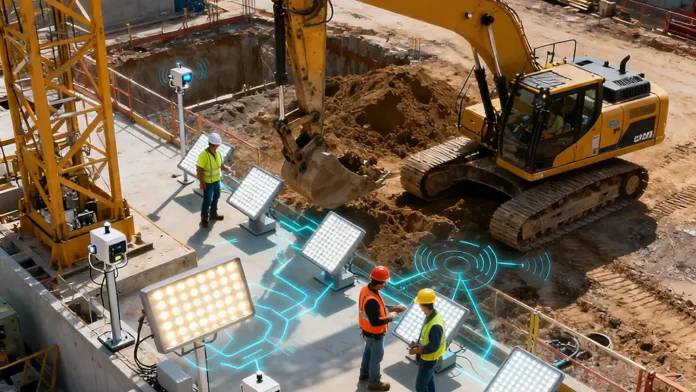Smart Lighting Systems Transforming the Construction Landscape
The construction industry stands at the threshold of a technological revolution where smart lighting systems construction initiatives are fundamentally reshaping how we approach building design, construction processes, and facility management. These intelligent illumination solutions represent more than mere upgrades to traditional lighting infrastructure; they embody a paradigm shift toward interconnected, responsive building systems that enhance efficiency, safety, and operational performance across the entire construction lifecycle.
The Foundation of Smart Construction Integration
Smart lighting systems have evolved from simple automated controls to sophisticated networks that integrate seamlessly with broader building management platforms. The construction landscape benefits from these systems through enhanced project coordination, improved worker safety, and optimized energy consumption patterns that begin during the construction phase and extend throughout the building’s operational life.
Modern construction projects increasingly specify Internet of Things (IoT) enabled lighting solutions that provide real-time data about space utilization, environmental conditions, and system performance. These installations create intelligent building ecosystems where lighting systems communicate with HVAC, security, and building automation systems to optimize overall building performance while reducing operational costs.
The integration of smart lighting systems during construction phases enables contractors to implement comprehensive testing and commissioning procedures that ensure optimal system performance from day one of building occupancy. This proactive approach reduces post-occupancy adjustment requirements while demonstrating the system’s capabilities to building owners and facility managers.
IoT Integration and Connectivity Protocols
The backbone of smart lighting systems construction applications relies on robust connectivity protocols that enable seamless communication between individual lighting fixtures, control systems, and broader building networks. These protocols have evolved to support various wireless and wired communication standards that ensure reliable performance across diverse construction environments.
Wireless mesh networks have emerged as particularly effective solutions for construction applications, providing redundant communication pathways that maintain system functionality even when individual components experience temporary connectivity issues. These networks self-heal and adapt to changing conditions, ensuring consistent performance throughout the construction process and beyond.
Power over Ethernet (PoE) systems represent another significant advancement in smart lighting construction applications, providing both power and data communication through single cables that simplify installation while reducing material costs. These systems enable precise control and monitoring of individual fixtures while supporting advanced features like daylight harvesting and occupancy-based control.
Enhanced Construction Site Safety and Monitoring
Construction sites present unique challenges where lighting systems must provide adequate illumination for complex work activities while adapting to changing site conditions and safety requirements. Smart lighting systems address these challenges through automated brightness adjustment, emergency response capabilities, and integration with site security systems.
Occupancy sensors and motion detection technologies enable construction sites to maintain optimal lighting levels in active work areas while reducing energy consumption in unoccupied zones. These systems provide enhanced safety for construction workers while demonstrating environmental responsibility that aligns with green building certification requirements.
Emergency response capabilities embedded within smart lighting systems provide critical safety features that can guide workers to safe locations during emergencies while automatically alerting site supervisors to potential hazards. These systems integrate with fire detection, security, and communication systems to create comprehensive safety networks that protect both workers and construction assets.
Project Management and Operational Efficiency
The data collection capabilities of smart lighting systems provide construction managers with unprecedented insights into project progress, space utilization patterns, and energy consumption trends. These insights enable more informed decision-making while supporting post-construction facility management planning.
Real-time monitoring capabilities allow project managers to track construction progress through lighting system activation patterns, identifying areas where work is proceeding and spaces that may require attention. This information supports more efficient resource allocation while improving communication between different construction trades.
Energy monitoring features provide detailed consumption data that helps construction teams optimize temporary power requirements while demonstrating the long-term operational benefits of smart lighting installations to building owners. This data supports both immediate project management needs and long-term facility operation planning.
Advanced Control Systems and User Interfaces
Modern smart lighting systems construction projects incorporate sophisticated control interfaces that accommodate both technical personnel and end users who may have limited experience with building automation systems. These interfaces balance advanced functionality with intuitive operation, ensuring that lighting systems remain accessible throughout their operational life.
Cloud-based control platforms enable remote monitoring and adjustment capabilities that support both construction and post-occupancy management requirements. These systems provide secure access to lighting controls while maintaining detailed logs of system performance and energy consumption that support facility management and sustainability reporting needs.
Mobile applications and tablet interfaces provide construction managers and facility operators with convenient access to system controls while supporting real-time troubleshooting and adjustment capabilities. These tools enhance system usability while reducing the need for specialized training that might otherwise limit system adoption.
Sustainable Construction and Energy Efficiency
Smart lighting systems construction applications directly support sustainability goals through intelligent energy management, automated demand response capabilities, and integration with renewable energy systems. These features reduce both construction phase energy consumption and long-term operational costs while supporting green building certification requirements.
Daylight harvesting capabilities automatically adjust artificial lighting levels based on available natural light, reducing energy consumption while maintaining consistent illumination levels that support construction activities and post-occupancy use patterns. These systems learn from usage patterns and environmental conditions to optimize performance over time.
Load scheduling and demand response features enable smart lighting systems to participate in utility programs that reward energy conservation during peak demand periods. These capabilities provide ongoing operational cost savings while supporting grid stability and environmental stewardship goals.
Integration with Building Information Modeling
The construction industry’s adoption of Building Information Modeling (BIM) technologies has created new opportunities for smart lighting system integration that support both design coordination and construction management processes. Smart lighting systems construction data integrates seamlessly with BIM platforms to provide comprehensive project documentation and performance tracking capabilities.
Digital twin technologies enabled by smart lighting systems provide real-time building performance data that validates design assumptions while supporting ongoing facility management optimization. These systems create valuable feedback loops that inform future construction projects while demonstrating actual performance against predicted outcomes.
Asset management capabilities embedded within smart lighting systems provide detailed tracking of component performance, maintenance requirements, and replacement schedules that integrate with broader facility management platforms. This information supports proactive maintenance planning while optimizing lifecycle costs and system reliability.
Addressing Implementation Challenges
The successful deployment of smart lighting systems construction projects requires careful consideration of network security, system interoperability, and long-term maintenance requirements. Construction teams must balance advanced functionality with practical considerations that ensure reliable performance throughout the system’s operational life.
Cybersecurity considerations have become increasingly important as lighting systems become more connected and capable. Construction specifications must address network security requirements, access control protocols, and data protection measures that protect both building systems and occupant privacy while enabling desired functionality.
Interoperability between different manufacturers’ components requires careful specification and testing procedures that ensure seamless system operation while avoiding vendor lock-in scenarios that might limit future system expansion or modification opportunities. Open protocol standards and standardized interfaces support long-term system flexibility and cost-effectiveness.
Future Developments and Emerging Technologies
The trajectory of smart lighting systems construction applications points toward even greater integration with artificial intelligence, machine learning capabilities, and advanced sensor technologies that will further enhance system performance and user experience. These developments promise to create lighting systems that learn from occupant behavior patterns while optimizing energy consumption and comfort levels automatically.
Edge computing capabilities integrated into lighting systems will enable more responsive local control while reducing dependence on cloud connectivity for basic system operation. These developments support both performance optimization and cybersecurity goals while enabling more sophisticated local decision-making capabilities.
Advanced sensor integration will expand smart lighting systems beyond illumination control to encompass air quality monitoring, space utilization tracking, and occupant wellness support features that create comprehensive environmental management systems. These capabilities will position lighting systems as central components of intelligent building ecosystems that support both operational efficiency and occupant satisfaction.
The evolution of smart lighting systems construction applications continues to accelerate as technology costs decrease and system capabilities expand. The most successful projects will be those that balance technological sophistication with practical implementation considerations, creating systems that deliver immediate construction benefits while supporting long-term operational goals and user satisfaction.































